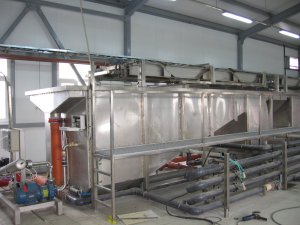Flotation for wastewater
Purpose
Flotation by dissolved oxygen is used for pre-treatment of high concentraded industrial water with higher volume of not-suspended matters and greases.
It is mostlyusedfor:
- Milk industry
- Slaughter houses
- Grease productions
- Poultry farms
- Fish industry
Advantages
- Very high separation efficiency even for bad sedimantation matters (small matters with density near to density of water)
- Significant decreasing of load for next treatment step, or for sewage system.
Principle of flotation
Flotation by dissolved oxygen is separation proces, which is used for separation of solid parts from liquid. Principle of separation of suspension by flotation is conglomeration of micro bubbles of air with flocks of created suspension. The result of conglomeration has less total specific weight then water and therefore it is floating up to water level. There is created flotation foam on water level, which is mechanicaly removed.
Flotation units are designed mostly for pre-treatment of high concentrated wastewater from food industry. They are used with excellent results in grease productions, slaughter houses, and poultry farms, milk industry nd other productions of food industry.
There is installed rotation drum filter (RDF) as a first pre-treatment step before flotation unit. Rotation drum filter is used for continual separation of not dissolved matters from wastewater (for example parts of bones, leathers, bristles, glass, paper, etc. The main working part is cylinder screen filter. The inlet of wastewater into RDF is by made by pump, or by gravity. The wastewater flow on cylinder screen filter and through spaces in screen. The meachanical dirties, which are bigger then spaces in screen stay on outside surface of rotating screen, where they are wiped out into container. The wastewater without mechanical pollution flow out from bottom part of RDF.
Flotation unit is put into operation by way, that it is filled by pretreated wastewater (on RDF) and then it is switched on circulation pump, and then it is connected pressure air on outlet of this pump. The pressure inside air-vessel is about 4,5 bar.
The stream of circulated wastewater saturated by air from air-vessel is lead by hoses into inlet throats. These throats are connected into inlet part or into flotation space as well. The air inside circulated wastewater on inlet part is loosen by influence of change of pressure in form of very small bubbles (size 30-50 µm). Step by step there is created in whole volume of inlet and flotation parts very soft air dispersion. There begin process of phyzical flotation, when small bubbles of air stick on pollution matters and start floating upwards up to the water level in flotation unit. By influence of big amount of air bubbles is this process very intensive, so this way it is gradually creating layer of flotated sludge on water level.
After it is wastewater pretreated (by flotation and by sedimentation), then flows through lamella separator, and finaly overflows ovr wall into outlet channel and out of flotation unit.
Flotation foam is wiped out by wiper from water level of flotation unit into outlet channel and then ito container.
The sedimentated sludge is discharged over the basin for catching this sludge.
There are adding to the flotation unit chmical units for increasing of efficiency (dissolving tanks, and storage tanks for preparation of chmical solution). The storage tank includes dosing pump. Then it is flotation unit supplement for pipe mixer, which is added into inlet pipe on flotation unit and it serves for mixing of inflowing wastewater with chemical solution. The effect of added chemical additives is reached precipitation of elulgated pollution, and created flocks of sludge are then very easily separated by flotation.
Alternative it is posible to use below coagulants:
Ferric sulfate Fe2(SO4)3
Aluminium sulfate Al2(SO4)3
It is also possible to use cationte polymer flocculant - for example: Zetag 92
It is possible to dosing sodium for reducing pH, or altrnatively to use sodium lye. The optimal type and dosing volume of chemicals is determined after so called coagulation and flocculation test.
Expected reduction of pollution
By using flotation unit it is strongly reduced primarily extracted pollution (greases), significantly it is reduced other pollution indicators BOD and COD. The reached efficiency values are written in below diagram:
| Indicator | Flotation | Chemical–phyzical flotation |
| Greases | 60-70% | 80-90% |
| SS | 60-70% | 80-90% |
| BOD | 30-40% | 55-65% |
| COD | 30-40% | 55-60% |
We have long experience and we tested many intallations, and it shown that in the most cases the food industry fatoies doesn´t need to use dosing of chemicals to reach sufficient reductions of pollution. It is very important proper adjustment of flotation unit.



